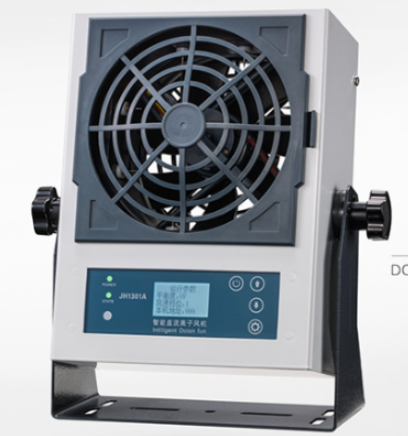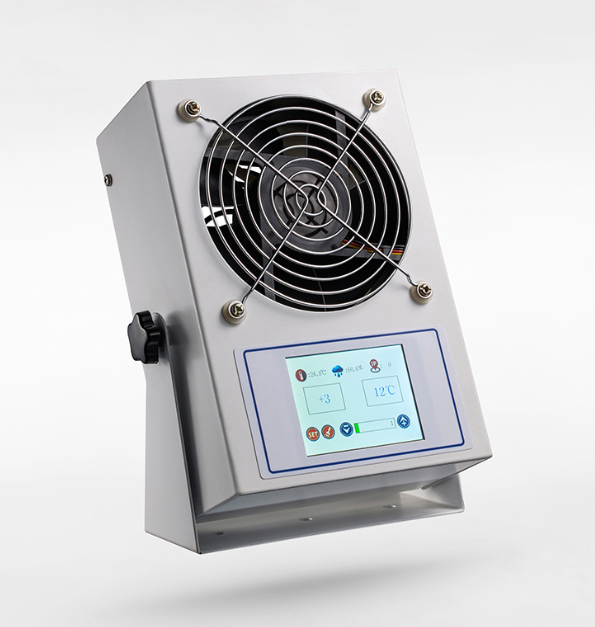
An ESD (Electrostatic Discharge) air ionizer is a device specifically designed to neutralize static charges in an environment where sensitive electronic equipment or materials are present. It works by emitting positive and negative ions into the air, which help neutralize static electricity on both surfaces and in the air. This is critical for protecting delicate electronic components from damage caused by electrostatic discharge (ESD).
The ionizer's primary function is to create a static-free environment, ensuring that static buildup is prevented or neutralized before it can cause harm to sensitive electronics, circuits, or components.
Ion Generation:
The ionizer uses high-voltage electrical fields to create positive (cation) and negative (anion) ions. These ions are released into the surrounding air.
Neutralizing Static Charges:
The ions emitted by the ionizer attach to static charges on nearby objects (such as electronic components, workbenches, or even people) and neutralize the charge. Positive ions attach to negative static charges and vice versa.
Air Circulation:
Many ESD air ionizers include a fan to help circulate the ions throughout the room or workspace. This ensures that the ions are evenly distributed to neutralize static electricity across a wide area.
Control of Airborne Particles:
As the ionizer emits ions, they also interact with dust and other airborne particles. The ions cause these particles to clump together and either fall to the ground or get trapped in air filters, further improving air quality.

Prevents ESD Damage:
The primary purpose of an ESD air ionizer is to prevent electrostatic discharge that can cause damage to sensitive electronic components, like microchips, processors, PCBs (printed circuit boards), and other delicate equipment.
Creates a Safe Workspace:
It helps create a safe working environment by reducing the risk of static shocks and the harmful effects of electrostatic discharge, especially in electronics manufacturing, assembly areas, and laboratories.
Improves Air Quality:
ESD ionizers also help clean the air by neutralizing airborne dust, pollen, and allergens, making the environment more comfortable and safer for workers.
Reduces Static in High-Risk Areas:
In areas such as cleanrooms, data centers, or high-tech manufacturing plants, where even minor static charges can cause serious damage, an ESD air ionizer is essential for static control.
Protects Electronic Equipment:
By neutralizing static charges around sensitive equipment, it ensures that devices such as servers, computers, and circuit boards are not exposed to the dangers of electrostatic discharge.
Electronics Manufacturing:
In assembly lines and production facilities where electronic components are being handled or assembled, the ionizer helps prevent ESD damage to chips, circuits, screens, and other components.
Cleanrooms:
In cleanroom environments where static control is critical for the proper handling of sensitive equipment and materials, ionizers are essential for maintaining a static-free environment.
Data Centers:
Data centers that house expensive and sensitive server equipment rely on ESD ionizers to avoid damage from static discharge during handling, maintenance, or upgrades.
Workbenches and Lab Stations:
Workstations that involve the assembly or testing of electronic devices, circuit boards, or semiconductors often use ESD ionizers to prevent damage and maintain a safe working area.
Home Electronics:
In home offices or entertainment rooms where computers, TVs, and audio equipment are present, ionizers help reduce static shock and protect valuable electronics from static damage.
Ion Balance:
The ionizer should have a balanced output of positive and negative ions to ensure that it can effectively neutralize static charges across a wide range of surfaces.
Airflow Control:
Many ESD air ionizers include adjustable airflow settings or fans to control how much air is circulated and how quickly the ions disperse throughout the room.
Monitoring and Control:
Some ionizers come with built-in monitors to measure the effectiveness of ion generation and ensure that the static neutralization process is working properly.
Adjustable Ion Output:
Depending on the application, some ionizers allow you to adjust the level of ion output based on the room size and the level of static control required.
Noise Level:
Look for a model that operates quietly, especially if you need it in an area where noise could be a distraction (like an office or lab).
Maintenance:
Consider the maintenance requirements. Some ionizers require cleaning of ionizing rods or filters, while others have self-cleaning mechanisms.
Compliance with Standards:
Ensure the ionizer complies with ESD control standards and has certifications like ISO 9001 or ANSI/ESD S20.20, which guarantee that it meets the required performance for static control.

An ESD air ionizer is an essential tool for maintaining a static-free environment in places where sensitive electronic equipment or components are handled. By emitting positive and negative ions, it neutralizes static charges and helps to prevent ESD damage. These devices are widely used in industries like electronics manufacturing, cleanrooms, data centers, and laboratories, and they are also beneficial in improving air quality by removing dust and allergens.
If you’re considering using an ESD air ionizer in your workspace, make sure to choose one with the appropriate features for your needs, including effective ionization, airflow, and maintenance requirements.
Would you like more details on specific models or how to choose the right one for your needs? 😊
Delivery is prompt!
By 10-year industry experts!
Diverse payment methods available!
Unbeatable cost performance!